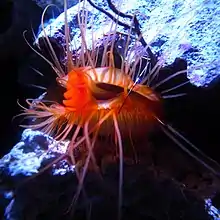| Ctenoides ales | |
|---|---|
 | |
| Scientific classification | |
| Domain: | Eukaryota |
| Kingdom: | Animalia |
| Phylum: | Mollusca |
| Class: | Bivalvia |
| Order: | Limida |
| Family: | Limidae |
| Genus: | Ctenoides |
| Species: | C. ales |
| Binomial name | |
| Ctenoides ales (Finlay, 1927) | |
| Synonyms[1] | |
| |
Ctenoides ales is a species of saltwater clam, a marine bivalve mollusk in the family Limidae, the file clams.[1] It is known by the names electric flame scallop, disco scallop, electric clam and disco clam. The clam has been given these nicknames because its soft tissues flash light like a disco ball. Along with Ctenoides scaber, they are among the only bivalves known to have light displays.[2]
The electric clam is widespread throughout the tropical waters of the central Indo-Pacific region from Indonesia to Palau Islands and New-Caledonia.[3]
Research by graduate student Lindsey Dougherty showed that the apparent flashing-light display of this clam is not a bioluminescence phenomenon, but is instead coming from reflection of the ambient light (sun or diving light). A staff member of the Lembeh Resort in Indonesia, where Dougherty was working with Dimpy Jacobs in August 2013, wrote, "The clams have a highly reflective tissue on the very outer edge of their mantle that is exposed and then hidden very quickly, so the change back and forth from the white reflective tissue to the red tissue creates the appearance of flashing".[4][5]
Dougherty went on to discover that the brightly reflective edge of the mantle of these clams contains nano-spheres made of silica, which are very reflective.[6]
In 2016, Dougherty published another study[7] of C. ales that suggested the flashing behavior was most likely developed for the purpose of predator deterrence.
References
- 1 2 Bieler R, Bouchet P, Gofas S, Marshall B, Rosenberg G, La Perna R, Neubauer TA, Sartori AF, Schneider S, Vos C, ter Poorten JJ, Taylor J, Dijkstra H, Finn J, Bank R, Neubert E, Moretzsohn F, Faber M, Houart R, Picton B, Garcia-Alvarez O, eds. (2022). "Ctenoides ales (Finlay, 1927)". MolluscaBase. World Register of Marine Species. Retrieved 18 February 2022.
- ↑ Dougherty, L.F.; Caldwell, R.L. (2013). Mechanism, ultra structures and behavioral function of flashing in Ctenoides ales: "electric scallops". Society for Integrative and Comparative Biology. San Francisco. Archived from the original on 24 September 2015. Retrieved 1 March 2019.
- ↑ "UCMP profile: Lindsey Dougherty". University of California Museum of Paleontology. Retrieved 2013-11-27.
- ↑ "Is the Electric Clam Really Electric? - Lembeh Resort and Critters at Lembeh in North Sulawesi, Indonesia". Lembehresort.com. 2013-08-21. Retrieved 2013-11-27.
- ↑ "Disco Scallops Know How to Boogie Even if They Aren't Scallops". Deep Sea News. 2013-01-26. Retrieved 2013-11-27.
- ↑ Sirucek, Stefan (2014-06-25). "How the "Disco Clam" Lights It Up Underwater". National Geographic Society Newsroom. Retrieved 2019-03-01.
- ↑ Dougherty, Lindsay (2016). Flashing in the 'Disco' Clam Ctenoides ales (Finlay, 1927): Mechanisms and Behavioral Function (PhD). UC Berkeley.
External links
- http://www.ubio.org/browser/details.php?namebankID=5521692
- Photos of Ctenoides ales on Sealife Collection